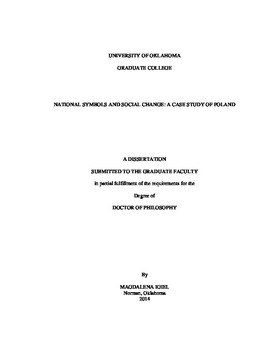| dc.contributor.advisor | Kramer, Eric | |
| dc.contributor.author | Igiel, Magdalena | |
| dc.date.accessioned | 2014-05-12T13:48:33Z | |
| dc.date.available | 2014-05-12T13:48:33Z | |
| dc.date.issued | 2014-05-09 | |
| dc.identifier.uri | https://hdl.handle.net/11244/10392 | |
| dc.description.abstract | This study focuses on national symbols and the communicative role they play in social change as it manifests itself in social movements and revolutions. Symbols in social movements and revolutions play a crucial role in binding people and groups together, allowing them to focus and form a collective consciousness. In order to contextualize such symbols within a specific national community and provide examples, the author chose her native Poland as a case study. The Polish national symbols included in this study are the cross, the Black Madonna of Częstochowa, and the contested landscape of the National Stadium in Warsaw. The framework used in this study to analyze the selected national symbols is Kramer’s theory of dimensional accrual of disassociation and the method is a semiotic analysis. Based on the discussion of national symbols in Poland, the study offers guidelines for how to recognize what national symbols are and to understand how they can affect social change. | en_US |
| dc.language | en_US | en_US |
| dc.subject | Speech Communication. | en_US |
| dc.title | National Symbols and Social Change: A Case Study of Poland | en_US |
| dc.contributor.committeeMember | Foster, Lisa | |
| dc.contributor.committeeMember | Cionea, Ioana | |
| dc.contributor.committeeMember | Meirick, Patrick | |
| dc.contributor.committeeMember | Beliveau, Ralph | |
| dc.date.manuscript | 2014-05 | |
| dc.thesis.degree | Ph.D. | en_US |
| ou.group | College of Arts and Sciences | |
